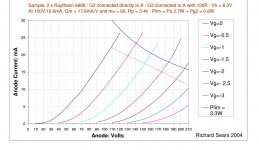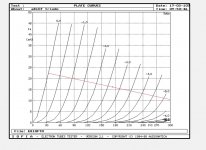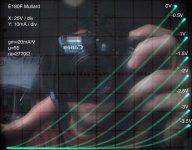Hi , someone could help me with the óptimun point to work the E180F tube , for do one 300b amplifier with only two stages..
Could be 170v 16ma?
Thanks
Santiago
Could be 170v 16ma?
Thanks
Santiago
Sure. Here's a 9K load line with the tube triode strapped with G2/G3 tied to plate. The other image is of the same operating point with G3 tied to cathode and G2 tied to plate (more conventional) and a 23K load.
(I'd rather use the more conventional arrangement with the 23K load)
You probably don't quite have the voltage to make all that work properly, but you can always redraw the load line for the voltage you do have available, or consider using a plate choke or CCS to make the available B+ much less important.
(I'd rather use the more conventional arrangement with the 23K load)
You probably don't quite have the voltage to make all that work properly, but you can always redraw the load line for the voltage you do have available, or consider using a plate choke or CCS to make the available B+ much less important.
Attachments
someone could help me with the optimun point to work the E180F tube
What in this case means "optimum" ? I know at least two such conditions.
The driver tube of 300B can be biased to make some amount of distortion cancelling.
This means, that with certain operating point the THD of the 300B will be reduced by the anti-phase distortion,
mainly 2nd harmonic, generated by the driver tube.
Are you looking for this ?
Or do you want to keep the THD of the driver as low as possible, and maintain the higher overall THD ?
Audiowize posted incorrectly, we're talking about E180F, not E810F.
My recommendation based on experience with Mullard and Siemens E180F is: Uak about 170 V and Ik about 11-12 mA, no more.
CCS and LED bias are desirable.
My recommendation based on experience with Mullard and Siemens E180F is: Uak about 170 V and Ik about 11-12 mA, no more.
CCS and LED bias are desirable.
Attachments
Last edited:
Then use a CCS at the anode. This combination will have THD some 5...10x smaller than with anode resistor.
The anode current can be choosen quite freely assuming the anode voltage is not less than 200 V.
Few years ago I did quite extensive test of different triodes and triode connected pentodes with a single 10M45S CCS + 100k load.
I got the following results with soviet 6J9P, which is equivalent with E180F:
+Ub = 350 V, Ua = 220 V, Ia = 12 mA, Uk = 3.8 V
Uout = 60 Vrms, THD = 0.40 %, G = 32 dB
The anode current can be choosen quite freely assuming the anode voltage is not less than 200 V.
Few years ago I did quite extensive test of different triodes and triode connected pentodes with a single 10M45S CCS + 100k load.
I got the following results with soviet 6J9P, which is equivalent with E180F:
+Ub = 350 V, Ua = 220 V, Ia = 12 mA, Uk = 3.8 V
Uout = 60 Vrms, THD = 0.40 %, G = 32 dB
Last edited:
Oops, you're correct, I posted the wrong curves.
The curves posted do suggest that a CCS will be very helpful.
The curves posted do suggest that a CCS will be very helpful.
Stimt.Uak about 170 V and Ik about 11-12 mA, no more.
CCS and LED bias are desirable.
Vg1 about 2V.
But...300B gate swing is about 160Vpp (at moderated operating point) in A1 mode (it's only 6-6.5W maximum output power!).
Trioded E180F "gain" is rather 40..45, so the driver is in the weak side, unable to drive 300B with low distortion (some years ago I measured 0.8-0.9% THD at this level).
The E180F driver "tone" is a little thin -IMHO-.
Big brothers, like E280F, D3a has greater gain (and better tone 🙂 ). I use them for about ten years in my 300B amp, but with source follower between VAS and 300B.
Santitrucco, why E180F? Do you already have some?
I have found the 6E5P is almost perfect for a two stage amp with a 300B on the output. I even use it to drive GM70.
Here is Ale Moglia's implementation which in turn is a variation of Rod Coleman's shunt cascode.:
6e5p – Bartola(R) Valves
Cheers
Matt
I have found the 6E5P is almost perfect for a two stage amp with a 300B on the output. I even use it to drive GM70.
Here is Ale Moglia's implementation which in turn is a variation of Rod Coleman's shunt cascode.:
6e5p – Bartola(R) Valves
Cheers
Matt
euro215255018 said:The E180F driver "tone" is a little thin -IMHO-.
Big brothers, like E280F, D3a has greater gain (and better tone 🙂 ). I use them for about ten years in my 300B amp, but with source follower between VAS and 300B.
Agree
For 300B driver, C3g (or 18040 in my case) is convincing
Last edited:
I have 6 tubes
If 6e5p have a gain factor in triode mode (u=30 ) why not to use e180f to drive 300B ?
If 6e5p have a gain factor in triode mode (u=30 ) why not to use e180f to drive 300B ?
First, you need a greater bias than 2V you get with the E180F.
And, as euro21 says, "The E180F driver tone is a little thin" for an output tube such as 300B.
And, as euro21 says, "The E180F driver tone is a little thin" for an output tube such as 300B.
why not to use e180f to drive 300B ?
Yes, why not ? Of course it will work perfectly.
Just take care that the operating point is correct. The example I gave earlier with a CCS is tested up to 80 Vrms and correct load impedance.
An other safe circuit is a mu-follower with a NFET as attached.
This can deliver easily some 200 Vpp to 47 k-ohms load, and with very low THD.
Someone can say that the sound of E180F / 6J9P is thin, but at the same time a dozen of listeners can say that it fat, rich or what ever.
Don't think that the opinions (about sound) given at various forums are universally correct. Try yourself.
Attachments
Last edited:
Artosalo, why so clipping E180F?
With a 2.8 V input voltage from CDP, THD of the E180F jumps into the sky.
With a 2.8 V input voltage from CDP, THD of the E180F jumps into the sky.
Sorry, but I am fully confused.
Why should anybody input 2.8 V into a tube ?
A potentiometer is already invented is a reduction of input signal is required.
Why should anybody input 2.8 V into a tube ?
A potentiometer is already invented is a reduction of input signal is required.
Let's do some basic calculations:
- 300B SE wants some 160 Vpp to be fully driven (in A1).
- mu of E180F as triode is some 50, with mu-follower, this is also the actual gain
So to get 160 Vpp from E180F as mu-follower requires 3.2 Vpp, i.e. some 1.1 Vrms.
- 300B SE wants some 160 Vpp to be fully driven (in A1).
- mu of E180F as triode is some 50, with mu-follower, this is also the actual gain
So to get 160 Vpp from E180F as mu-follower requires 3.2 Vpp, i.e. some 1.1 Vrms.
- Status
- Not open for further replies.
- Home
- Amplifiers
- Tubes / Valves
- Operation point for E180F tube



